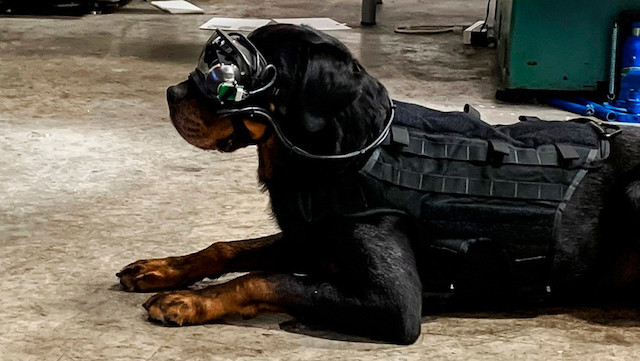
The Small Business Innovation Research program, led by the U.S. Army Research Office, has funded Seattle-based small business Command Sight Inc. to provide military dogs with augmented reality headsets. They allow the handler to give them directional commands while the dog operates at a distance from its handler and out of its field of vision, often to spot explosive devices, hazardous materials or assist in rescue operations. These glasses could prevent soldiers from being put in danger.
A prototype of augmented glasses
Dr. A.J. Peper, founder of Command Sight, set out to make the first prototype augmented reality glasses for military dogs when he identified a need to increase the effectiveness of communication between dog and handler through his interactions with operational military forces. This could change the way military dogs are used in the future.

Dr. Stephen Lee, a scientist who works for the military, said:
“Augmented reality works differently for dogs than for humans. It will be used to provide dogs with commands and cues; it’s not up to the dog to interact with it like a human would. This new technology gives us a critical tool to better communicate with military dogs.”
The glasses fit each dog with a visual indicator that allows the dog to be directed to a specific location and react to the visual cue in the glasses as France Bleu reports. The handler can see everything the dog sees to give commands through the headphones that the glasses are equipped with.
For now, the prototype is wired, so the dog must be held on a leash, but researchers are working to make it wireless.
Dr A.J. Peper said:
“We are in the early stages of researching the application of this technology to dogs, but the results of our initial research are extremely promising. Most of the research to date has been done with my Rottweiler, Mater. His ability to transition from conventional training to working with the augmented reality glasses has been incredible. We still have a ways to go from a basic science and development standpoint before they are ready for the wear and tear our military dogs will put on units.”
From hand signals to visual signals
The basic scientific research behind the technology is focused on understanding canine vision and cognition. Dr Stephen Lee, said:
“We will be able to probe canine perception and behaviour in a new way with this tool.”
Today, dogs are directed by hand signals or laser pointers (the handler must be in sight or close to the dog). Audio communication, using a camera and radio transceiver placed on the dog, is also used and allows the handler to be further away from the dog, but verbal commands can be confusing for the dog. Augmented reality glasses offer a new alternative to dogs and their owners.
Dr Stephen Lee said:
“The military working dog community is very excited about the potential of this technology. This technology really opens up new avenues and possibilities that we haven’t considered before.”
The augmented reality system uses goggles that the dogs are already accustomed to wearing to protect themselves from the weather and aerial deployments of Rex Specs, making it easier for them to accept.
Dr Stephen Lee said:
“Even without augmented reality, this technology provides one of the best camera systems for military working dogs. Currently, cameras are typically placed on the dog’s back, but by placing the camera in the goggles, the handler can see exactly what the dogs are seeing and it mitigates the image jumps associated with the camera placement on the dog’s back.”
A promising next phase of development
The Command Sight team will move into Phase II of the SBIR program, which funds research and technology development with small businesses. Unlike basic research programs run by the Army, the SBIR program focuses primarily on feasibility studies leading to the demonstration of prototype technology for specific applications.
In addition, the Department of Defense Rapid Reaction Technology office has provided funding for the next phase of development. With this funding, Command Sight is currently working with Navy Special Forces to build prototypes to be tested on their military dogs. Each of the dogs has been 3D scanned to obtain dimensional data to understand where to place the optical and electrical components, specific to each dog.
Translated from Aux États-Unis, une entreprise équipe les chiens militaires de casques de réalité augmentée









